London’s theatrical scene at the end of 2018 seemed centered on a response to the year’s many #MeToo revelations and newspaper headlines. I saw over a dozen plays in three weeks, while taking a group of students from Union College on a theatre-focused “mini-term” course. In productions at Shakespeare’s Globe’s Wanamaker Playhouse, the National Theatre, the Royal Court, and on the West End, women and the challenges they face from patriarchal oppression were, in many of the shows I saw—with a few notable exceptions—placed front and center.
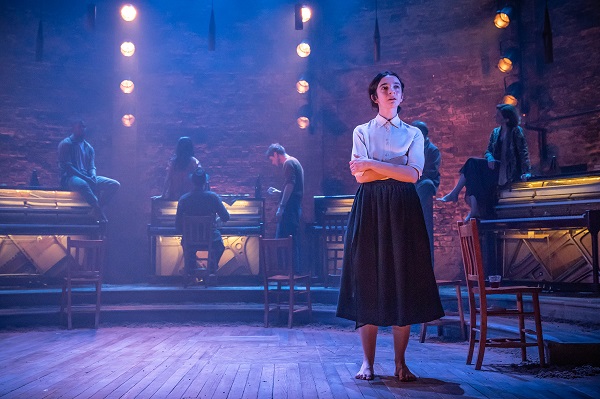
Tennessee Williams’s Summer and Smoke, directed by Rebecca Frecknall. Photo: Marc Brenner.
The first two shows I attended were American plays on West End stages. Tennessee Williams’s Summer and Smoke was staged at the relatively small Duke of York’s Theatre, having transferred from a critically lauded run at the Almeida Theatre. Rebecca Frecknall’s haunting production was presented on an almost bare stage; Tom Scutt’s set consisted primarily of a set of pianos surrounding a bare wooden playing space. The actors were barefoot throughout, and at many times playing the pianos, which were also rigged to light up “like fitful lightning in a cloud” at dramatic moments. Williams’s play depicts the tragic failed romance of Alma, a young woman searching for spiritual love, and John, a doctor grounded in physical and sensual pleasures. Frecknall’s production was unabashedly feminist, focusing on Alma. Patsy Ferran was luminous in the role, commanding the audience’s attention and empathy from the opening moment, when she stepped alone onstage and began to vocalize, as if having a seizure or religious experience (Ferran won the Olivier Award for her performance, and the production won the Olivier for Best Revival). Frecknall’s production depicted her disillusionment and descent from minister’s daughter to local prostitute—while John ends up relatively okay, married to Alma’s former music pupil—as the result of her societal marginalization due to her unapologetic acceptance of her female sexuality. As Alma’s dreams disintegrated, a mess accrued on Scutt’s set: cards, dirt, bits of dropped ice cream—all of which the actors had to walk over in their bare feet, further muddying the world of the play with their human stain.
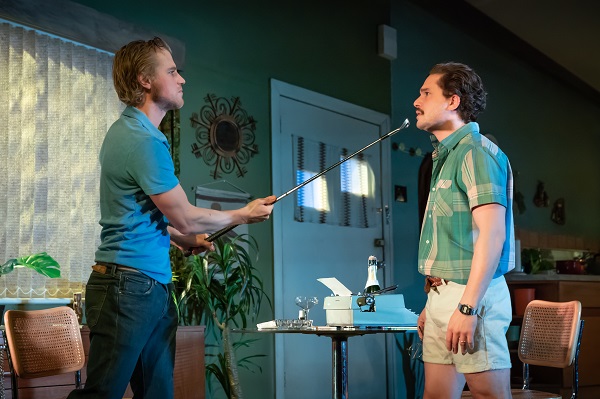
Sam Shepard’s True West, directed by Matthew Dunster. Photo: Marc Brenner.
The second show I attended was one of the few not focused on women’s stories: a celebrity-led production of Sam Shepard’s True West at the Vaudeville Theatre. Kit Harrington, who had finished filming the yet-to-be-released final season of Game of Thrones, starred as Austin, and musician and actor Johnny Flynn (who also co-wrote the music for the show) played his brother Lee. The two were superbly matched in Matthew Dunster’s production. The show opened with Harrington onstage, trying to write. Wearing shorts, sporting a ’70s moustache, and using a perfect Californian accent, he looked and sounded nothing like the character of Jon Snow that brought him to immense fame. Flynn’s Lee entered like a menacing desperado. Yet each carefully revealed his potential to transform into the other: Harrington’s shorts showed off his muscular calves—he was clearly a man with the potential to perform violence. And Flynn’s Lee clearly longed for the stability represented by their mother’s bungalow. Jon Bausor’s design was meticulously detailed down to American power outlets—and numerous working toasters, as demonstrated in a key scene in which the smell of toast wafted throughout the Vaudeville theatre. Yet as Bausor’s angular forced perspective demonstrated, there was something off, not quite real, about this world, and in the final moments of the play, as the set disappeared to reveal the fantastic desert landscape present in Shepard’s closing stage direction, we saw that the two brothers were like mirror images of one another, locked in an eternal struggle. (It’s worth noting that running at almost exactly the same time as Dunster’s production, another production of True West, directed by James Macdonald and featuring Paul Dano as Austin and Ethan Hawke as Lee, appeared on Broadway to mediocre reviews—I missed that one.)
Both Summer and Smoke and True West deal with reversals. Williams’s Alma turns from religious fanatic into a sex worker, and John from a sexually obsessed atheist into a man searching for the transcendent, yet unable to find it in the girl he’s lived near his whole life. Shepard’s Austin and Lee are like the two halves of the playwright: as Austin transforms from author into troubled outsider, his brother Lee performs the reverse transition. Both were effective and entertaining West End productions, but little more could be said about True West. Summer and Smoke, though, was much more: through Ferran’s performance and Frecknall’s feminist vision, the production tapped into a deep well of feminine anguish that made the play as tragic today as it was when Williams wrote it over half a century ago.
In London, the reconstructed Shakespeare’s Globe is perhaps more of a tourist attraction, educational institution, or gimmick than it is a venue for innovative and exciting theatrical work. Nonetheless, I saw two shows there, in the venue’s Wanamaker Playhouse, an indoor recreation of the King’s Men’s Blackfriars space, which is utilized by Shakespeare’s Globe for performances during the winter months. The shows were Marlowe’s Doctor Faustus and Shakespeare’s Macbeth, paired around a theme of “the dark night of the soul”: there was also a symposium of scholarly talks on 8 December at the Globe’s Education Center entitled “Perdition Catch My Soul: Shakespeare, Hell and Damnation,” at which I presented a paper on Othello and Twelfth Night. Both Faustus and Macbeth were mediocre productions: museum theatre, or what Peter Brook would call “Deadly Theatre” for the most part, that almost put me to sleep.

William Shakespeare’s Macbeth, directed by Robert Hastie . Photo: Johan Persson.
Each did have exciting moments or elements. In Robert Hastie’s production of Macbeth, which starred the Globe’s Artistic Director Michelle Terry as Lady Macbeth and her actual husband Paul Ready as Macbeth, those few moments came during periods of darkness, when the Wanamaker was transformed into an immersive space. Owing more to contemporary productions like Sleep No More than to historical traditions of performance, actors circled the halls outside the auditorium, banging on doors, spooky voices emanated from who-knows-where, and then the darkness would be pierced by candlelight. These few moments evoked bits of primal terror—and I wish I could have said the same for the performances of Ready, Terry, or any of the rest of the cast.
Director Paulette Randall’s gender-swapped production of Doctor Faustus was a bit more engaging throughout. Still, the most exciting moment came from a bit of staging, as Faustus’s books and study were suddenly swallowed into the pit below the stage in the moments when she decided to summon the devil. Randall cast a black actress, Jocelyn Jee Esien, as Faustus and the deliciously Machiavellian Pauline McLynn as Mephistopheles. There was great potential for a strikingly relevant production here: a brilliant black female scholar certainly could have faced immense oppression in her career, and we could further empathize with her decision to abandon her scholarly life in order to “live deliciously” and burn down the whole system. Yet despite the casting, Randall’s production virtually ignored the bodies of its lead actors, rarely altering the text and continuing to use the male pronouns “he” and “his” for Faustus and Mephistopheles. The production seemed to be at war with its own obviously relevant concept.
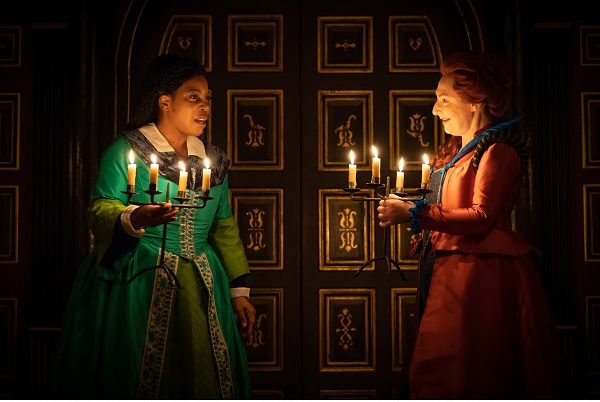
Christopher Marlowe’s Doctor Faustus, directed by Paulette Randall. Photo: Marc Brenner.
In giving this assessment of the Globe’s Faustus and Macbeth, I must make a few caveats: one is that I’m not a great fan of “original practices” Shakespearean performances—I think the very term is deceptive, promising something that is entirely impossible to deliver—and that in both cases my experience was hampered by the sheer discomfort and terrible sightlines from the Wanamaker’s gallery. While part of the theatre-going experience at the Wanamaker involves “hearing” plays in conditions very like those in which Early Modern English playgoers experienced theatre, the inability to see the stage or sit comfortably can be confounding to modern audiences. I would probably have rather seen something during Emma Rice’s brief tenure as Artistic Director of Shakespeare’s Globe, before she was sacked for being too innovative and ignoring the theatre’s stodgy mission. However, Terry should be lauded for one notable departure from “original practices”: she has announced a commitment to producing seasons with diverse, gender-balanced casts. Although some shows will still be all male (in line with Early Modern English tradition), others will be all female to balance this out, and the rest will have gender parity. My final caveat about my experience in the Wanamaker is that it is an undeniably exciting experience to watch (what one can of) a play entirely by candlelight. It also requires a totally expanded skillset from all actors involved, since they must perform their roles while carefully carrying the production’s lighting devices!
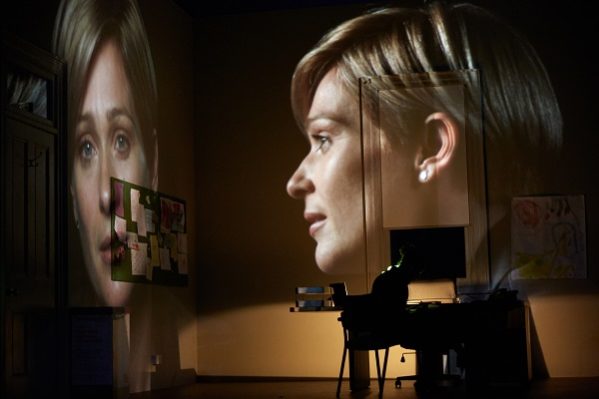
David Hare’s I’m Not Running, directed by Neil Armfield. Photo: Mark Douet.
Over the course of my time in London, I saw four shows at the National Theatre—two on the institution’s main stage, the Olivier, and one in each of the smaller spaces, the Lyttelton and Dorfman theatres. Three of these shows dealt with the sort of people or figures we are encouraged to idolize and mythologize: politicians, in David Hare’s new play I’m Not Running; historical figures in Shakespeare’s Antony and Cleopatra; and ancient gods and heroes in Anaïs Mitchell and Rachel Chavkin’s Hadestown.
Hare’s new play, I’m Not Running, was, unfortunately, the weakest of all the shows I saw in London. It was essentially a fantasy, fueled by the troubles affecting the U.K.’s dysfunctional Labour party, in which Hare wrote into existence an ideal candidate for a new party leader. This character, Pauline Gibson (compellingly played by Siân Brooke), is a Labour MP who entered politics after starting a grassroots campaign to save the local hospital where she was a doctor. She comes into conflict with her college boyfriend, Jack Gould (Alex Hassell), who has been groomed throughout his life of privilege to be the leader of the Labour Party. Gould has done “everything right”—made all the proper compromises, espousing politics that are centrist at best if not sometimes downright conservative—in order to assure his eventual leadership of the party. In contrast, Gibson is the real deal: having grown up poor with an alcoholic mother, she constantly fights for what she believes in and engages genuinely with her constituents, all the while promising that she’s not running, not planning on upending the order of things and challenging Gould’s assured position. Of course, she is running. Ultimately, the most compelling aspect of Hare’s play had nothing to do with politics, and everything to do with toxic masculinity: Hassell’s Gould was clearly most affronted by the fact that the person challenging his authority was a competent woman. The play’s thin fantasy was, however, engagingly brought to life by the superb acting of Brooke, who effectively played Gibson at many points throughout her life from college-to middle age, and by director Neil Armfield and set designer Ralph Myers, whose rotating white stage was swiftly transformed in transitions that effectively deployed video projections by Jon Driscoll.
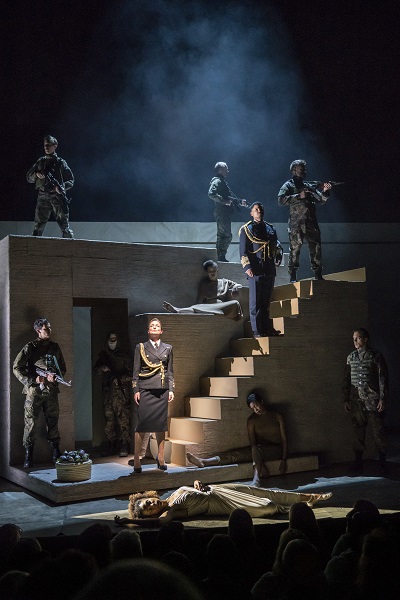
William Shakespeare’s Antony & Cleopatra, directed by Simon Godwin. Photo: Johan Persson.
Another rotating stage appeared in Simon Godwin’s spectacle-filled and celebrity-fueled production of Antony and Cleopatra, starring Ralph Fiennes and Sophie Okonedo. In this case, Hildegard Bechtler’s set rotated to show on one side the desert paradise of Alexandria, and on the other an ultramodern, sterile Rome, as if these two locations were, indeed, the two opposite halves of the world. The show was costumed in modern dress by Evie Gurney and featured video design by Luke Halls designed to replicate images of today’s drone warfare in the Middle East. But by opening the production with the final scene of Octavius Caesar’s victory, Godwin’s production emphasized the historicity of Shakespeare’s play. Even when Cleopatra appeared in a costume evoking today’s “Queen Bey” Beyoncé Knowles, the characters and actions felt distant, heroic, and lacking in any real relevance to today’s global politics. The production was, despite all its spectacle, a story of political foibles and war caused by the unstoppable, irrational, middle-aged passions of two world leaders who found themselves acting like teenagers. Unsurprisingly, much of the supporting cast—a diverse group of actors who spoke well and comported themselves with rather boring dignity and gravitas—were entirely unmemorable. But in their scenes together, Fiennes and Okonedo sizzled—throughout the production, it was apparent why they are stars.
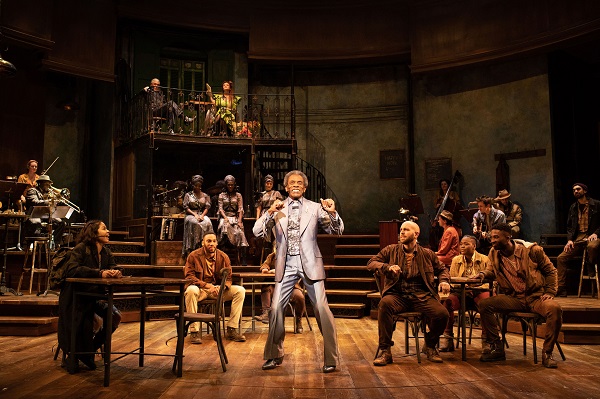
Anaïs Mitchell’s Hadestown, directed by Rachel Chavkin. Photo: Helen Maybanks.
The best production I saw at the National, though, was Anaïs Mitchell’s take on the Orpheus and Eurydice myth, Hadestown, which has since gone on to win the Tony for Best Musical on Broadway. I first saw Hadestown in 2015 in downtown New York at the New York Theatre Workshop, and was excited to see the more expanded version. My full review of this production is forthcoming in Theatre Journal; what follows are abbreviated notes from that review. As its many Tony Awards demonstrate, the show has a kind of magic to it—or at least an appeal to mass audiences. Some of that is rightly due to the legendary André De Shields, who went on to win his first Tony award for his role as Hermes, the show’s narrator, and Amber Gray’s Persephone and Patrick Page’s Hades, the hearts of the show. The show is particularly resonant today because of Hades’s isolationist song “Why We Build the Wall,” which feels on the nose in the age of Trump—although the song and show were written nearly a decade before Trump even declared his candidacy. Even more praise is due to Mitchell, who wrote the book, lyrics, and music, which can best be described as a set of unforgettable bluegrass-inspired, jazz-funeral tinged, folky showtunes. Mitchell developed Hadestown in collaboration with her director, Rachel Chavkin, known for her work on innovative musicals from the TEAM’s Mission Drift to Dave Malloy’s Natasha, Pierre, and the Great Comet of 1812. Another contributor to the show’s success may very well be its source material: the story of Orpheus and Eurydice has been repeatedly retold in the theatre, so much that Joseph Roach has even described the very forms of theatre and performance as “Orphic”—imperfect, flawed, always unfinished, “moving forward and glancing back.”
Another move forward and glance back were two productions by Scottish playwright Anthony Neilson, running at the same time. Also at the National, Neilson was directing the premiere of his new play The Tell-Tale Heart, based on the short story by Edgar Allen Poe, in the National’s relatively smaller Dorfman Theatre. And at the fringe Southwark Playhouse, I was able to see Alex Sutton’s terrific revival of Neilson’s 1995 The Night Before Christmas.
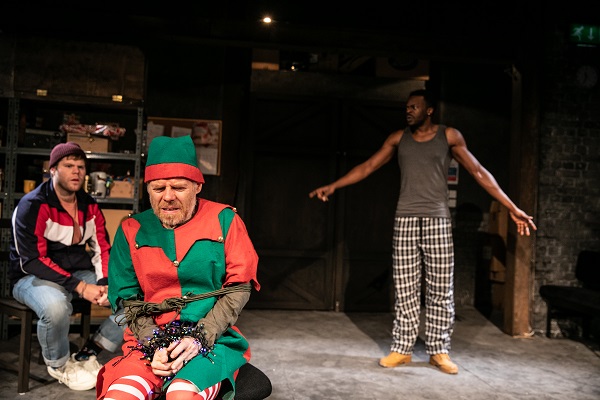
Anthony Neilson’s The Night Before Christmas, directed by Alex Sutton. Photo: Darren Bell.
The revival of The Night Before Christmas was essentially an anti-panto holiday show for adults. Running just over an hour, it deals with two chums, the amiable Gary (Douggie McMeekin) and fiery Simon (Michael Salami), who have apprehended an “Elf” (Dan Starkey) inside the warehouse—filled with “mostly legal” goods—where the Gary works. They argue: is he really a Christmas elf, having fallen off of Santa’s sleigh, as he says, or is he perhaps just a small criminal, cleverly dressed and having snuck into the warehouse to steal things or recover his stashed drugs? Along the way, the sex worker Cherry (the excellent Unique Spencer) shows up, demanding the set of Power Rangers toys she was promised for her child in exchange for services she has performed for Gary. The elf extolls the power of the Christmas spirit (which is apparently conveyed by a magical white powder with many of the same properties as cocaine), and promises each of them a wish if they let him go. Spoiler: they do, and they each get one (sadly limited and unexceptional) wish fulfilled. The show had my students—and me—doubled over in laughter, yet also contained some of the most serious and emotionally affecting moments from my week of theatre-going. One of these was Simon’s screed against capitalism, in which he articulates the way that systems of power don’t just limit the opportunities of the marginalized, but limit their very dreams. In another moment, in which Starkey’s Elf, with tear-filled eyes, struggled to explain how some children could lose their wonder at the Christmas spirit due to abuse, one could hear a pin drop in the theatre. And of course there was Cherry’s brazen unwillingness to be silent, as a sex worker and mother who is unable to afford a simple set of toys for her child.
Sutton’s revival was a success on nearly every front. Its small cast was superb both physically and emotionally, but also vocally, as their disparate accents revealed the characters’ lower-class upbringings. The Southwark Playhouse is an extremely intimate space, seating only around 100, meaning we were inches from the action. And designer Michael Leopold’s set looked every bit like the dingy warehouse where the play was set—until the final moment revealed a number of joy-inducing surprises, including a fully decorated Christmas tree strung with numerous colorful lights. The final moment was one of Sutton’s several departures from Neilson’s text, in which the final stage direction is ambivalent, not joyous. Moreover, although most of the production felt fully rooted in the late 1990s (down to the Power Rangers and flip phones), Sutton sprinkled in contemporary references which inevitably drew laughs yet also pulled me a bit out of the world of the play.
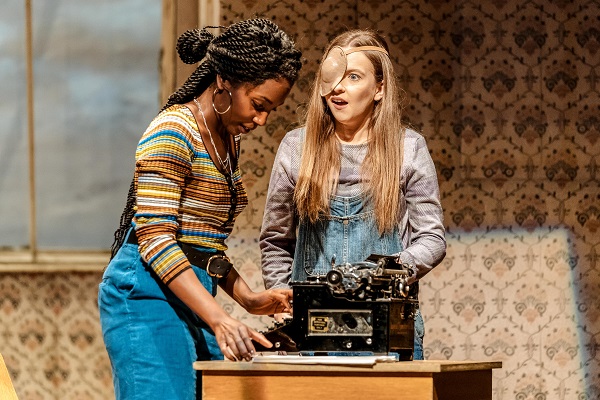
Anthony Neilson’s adaptation of Poe’s The Tell Tale Heart, directed by the author. Photo: Manuel Harlan.
Neilson’s adaptation of Poe’s The Tell-Tale Heart, which the playwright directed with great imagination, was unabashedly contemporary. Poe’s tale (printed in the theatrical programme) deals with a protagonist who murders an old man due to his irrational hatred of the man’s eye, then eventually confesses the crime to the police, since his insanity and guilt lead him to hear the murdered man’s heart beating from where his dismembered body lies beneath the floorboards. In Neilson’s adaptation, the protagonist is a woman of color, the playwright Camille (Tamara Lawrance), who has won, and turned down, a major award and retreated to a seaside flat to work on her second play. Imogen Doel played her landlady, Nora: a sweet, somewhat weird painter who wears a mask over one half of her face because she has a disfigured eye. Gradually, the two enter a relationship, and, promising acceptance, Camille asks to see Nora’s full face. Again, a spoiler—it is a terrifically horrific eye, bulging out appallingly (Francis O’Connor’s design was fantastic throughout, from this prosthetic to other props and set pieces that begin to move or transform grotesquely as Camille’s insanity intensifies). Murder and an abundance of blood and gore ensue, and soon Nora’s ghost is haunting Camille, and a detective (David Carlyle) is on the scene, interviewing Camille about the landlady’s disappearance. But sometimes Carlyle’s character had hair, sometimes he didn’t. Once, he mentions the disappearance of the writer’s tenant, not landlady. Clearly, not everything is as it seems. The double resolution Neilson provides at the end—which is a bit overly complex and which I’m not going to spoil here—was somewhat unsatisfying, if clever. In fact, it felt as if that cheeky cleverness was a major part of what the author was shooting for throughout, with snide references to everything from contemporary politics to other parts of the National and London season (including the shows I’ve reviewed above and Company, below). The first half of the show, with its emotional relationship between the two women, leading up to a murder caused by insane intolerance, was genuinely affecting. The jump scares in the second half were more the stuff of horror comedy. On the other hand, O’Connor’s design and Neilson’s direction created a visually stunning experience, as walls became transparent and the slanted window that took up most of the upstage wall, which mostly just reflected the set, started becoming a screen across which video designer Andrzej Goulding sent haunting images.
Neilson came to the fore in the 1990s as part of the “in-yer-face” theatre movement, which found its most noteworthy home at the Royal Court, a theatre in Chelsea known for championing new British Drama, including John Osborne’s Look Back in Anger, Edward Bond’s Saved, Richard O’Brien’s The Rocky Horror Show, many works of Caryl Churchill, and, in the 1990s, the in-yer-face plays of Sarah Kane and Mark Ravenhill. I took my students to two shows there: in the theatre’s larger space downstairs, The Cane, a new play by Ravenhill, was being staged. In the tiny upstairs space, the twenty-eight-year-old playwright and actor Ellie Kendrick was presenting her first produced play, the feminist performance piece Hole. Both were, to my mind, of mixed quality, but certainly worthwhile new works by British playwrights.
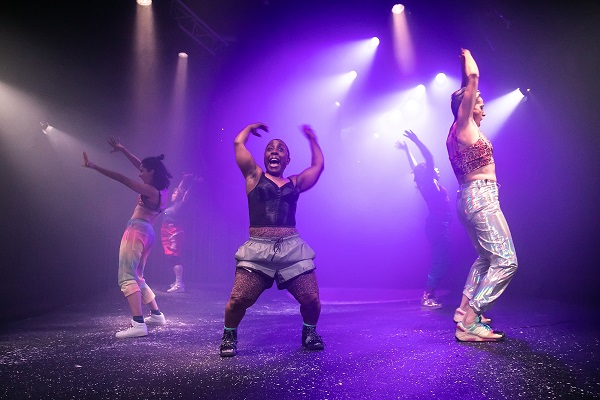
Ellie Kendrick’s Hole, co-directed by Helen Goalen and Abbi Greenland. Photo: The Other Richard.
Hole was co-directed by Helen Goalen and Abbi Greenland, and featured the ensemble cast of Ronkẹ Adékoluẹjo, Ebony Bones (who also composed the music), Alison Halstead, Rubyyy Jones, Cassie Layton, and Eva Magyar. The entire creative team was female. Much had changed in the play’s development: the poetic text, lacking stage directions, was originally written for three actresses—perhaps hearkening to the untamed and otherized femininity of Shakespeare’s witches in Macbeth—but here presented with six. In Goalen and Greenland’s vision, the show was a choral ode to femininity, and a choral fury against patriarchal oppression. The actors represented diverse visions of femininity: to name only three, Bones is a model and recording artist; Halsted, who is bald and 4’6”, is an acrobat and clown; Jones is a self-described “burlesque/queerlesque sex education performer.” In the opening sequence, each woman struggled to tell a story of abuse, before being silenced by a buzzer and slowly lowered into a hole below the stage. Then the six reemerged, empowered and angered, reclaiming the stage in what was in turns a dance, rock concert, and aggressive self-empowered burlesque act.
At the end of the show, one of my (female) students applauded longer and louder than she did at any of the other shows we saw on our trip. In contrast, three of my (male) students couldn’t get out of the theatre fast enough, unwilling to stay for the talkback with the playwright and directors. This alone suggests that Kendrick’s debut work did its job. On the other hand, I hesitate to call this performance piece a play. It felt a bit more like a “happening” or a dramatic poem—full of classical and contemporary references and raging against current injustices, brimming with ideas, but lacking any real structure.
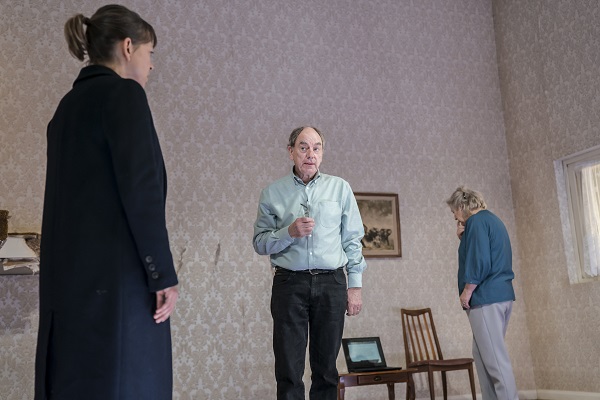
Mark Ravenhill’s The Cane, directed by Vicky Featherstone. Photo: Johan Persson.
In contrast, Ravenhill’s three-hander The Cane is a meticulously structured work. Alun Armstrong played Edward, a supposedly beloved teacher on the verge of retirement, who is also assistant head of a struggling government-run (what Americans would call “public”) school. But unseen masses of his students are picketing outside his home, having learned that years ago, when it was permitted and required, he would administer corporal punishment (caning). Into this scene comes his estranged daughter, Anna (Nicola Walker), an employee of the Academy school (what we would call for-profit charter schools) movement. Edward’s wife and Anna’s mother, Maureen (Maggie Steed) consistently takes Edward’s side, wondering how Anna can be so horrible to her father. But as a horrific outburst reveals, Maureen may be less of a loyal ally than she is Edward’s victim, emotionally bullied throughout their marriage. And on the wall upstage remain indentations from when Anna, in a rage as a child, attempted to murder her father with an axe. Has she returned home to help Edward write a report that can save his school, or has she come back to finish the job she started years earlier? And what is the shameful secret that Edward is hiding in the attic of his and Maureen’s home? In Aristotelian mode, the surprises that Ravenhill sets up in his play are entirely inevitable reversals, revealing that no one is innocent and no one will be saved.
Under Vicky Featherstone’s taut direction, the play ran a tight 105 minutes without intermission, although it is perfectly divided into two acts by the scene in which Edward goes up into his attic to retrieve (what else?) the cane. Chloe Lamford’s expressionist design turned this family drama into something of epic proportions. The vertical space of the set was extended unrealistically, so that when Edward had to ascend to the attic, the ladder he used was absurdly tall. Then the attic descended, as if to crush the residents of the besieged home. The staircase stage right was cut off in a cross-section, making it look rotten. And the room was almost without furniture or decoration, save a few necessary props (a chair and table), the axe marks on the wallpaper, and an illustration of elephants. Lamford’s set, Featherstone’s direction, the performances of the three extraordinary actors, and Ravenhill’s mastery of dramatic structure could not, however, overcome some of the play’s misogynist distastefulness. The play seems, in part, to blame Maureen for the emotional abuse she had suffered from her husband, and to paint Anna as an cruel avenging harpy without any particular cause, returning home to destroy her father for no real reason just as she had tried to kill him as a child, all while espousing the jargon of an Academy administrator. Perhaps Ravenhill is just trying to present a “fair and balanced” vision of the family, since even Edward, unlike the soon-to-be extinct elephants on his wall, doesn’t arouse much sympathy. But in this production of a play about the abuse of power, it wasn’t quite clear what we were supposed to take away from Edward’s inevitable downfall.

Stephen Sondheim’s Company, directed by Marianne Elliott. Photo: courtesy Gielgud Theatre.
The final two shows I saw in London were, once again, on the West End, and this time without the majority of my students. Marianne Elliott’s gender-swapped revival of Stephen Sondheim’s Company was easily the most vital revival of a musical that I have seen in numerous professional productions. Many productions of Company can feel quite dated now: the story of a thirty-five year old single man questioning his status as a bachelor, while his married friends experiment with pot, open up about their sexuality, or start to doubt their relationships, feels wholly like a product of the early 1970s, nearly half a century ago. For this production, however, Bobby became Bobbie, and everything changed. Played by Rosalie Craig, this single and unabashedly sexual woman turning thirty-five made sense dramatically and emotionally as a character living today. Bobby’s three girlfriends, April, Marta, and Kathy, became Bobbie’s three boyfriends, Andy, PJ, and Theo. While (the male) Bobby’s toying with the heartstrings of the airheaded flight attendant April is now one of the saddest and most distasteful parts of the original show, it was entirely refreshing to see Craig’s Bobbie in bed with—and clearly not looking for a relationship with—the Ken-doll-esque Richard Fleeshman as Andy. And while the young and vulgar Marta may seem hip and cool, putting the exact same words into the mouth of George Blagden’s PJ made the character into a grotesquely pretentious and self-involved misogynist: it’ll be hard to hear “Another Hundred People” the same again. Elliott also gender-swapped Amy, turning her into Jamie (Jonathan Bailey), about to enter a same-sex marriage with Paul (Alex Gaumond). Bailey’s rendition of “(Not) Getting Married Today” was manic and hilarious, and Bobbie’s off-the-cuff proposal to her gay friend Jamie in the wake of this song was a jaw-dropping moment that managed to land incredibly effectively. And of course Patti LuPone was showstopping as Joanne, a role she is meant for, and has played previously, in the 2011 New York Philharmonic version that starred Neil Patrick Harris as Bobby. Elliott’s slight revision to Joanne’s indecent proposal to Bobbie at the end of the show again made complete sense in the world of the show.
Elliott’s concept—magnificently supported by Bunny Christie’s designs—was to have the show be a modern-day Alice in Wonderland, with Bobbie constantly opening doors and finding herself in new and strange situations. Yet, as in Lewis Carroll’s story, not everything was entirely happy for the sexually liberated Bobbie in this very adult wonderland. In a stunning montage sequence making excellent use of the rest of the supporting cast as doubles, Bobbie imagined herself settling down and having a child. Turning thirty-five had clearly triggered her biological clock, and nearly every scene featured the number “35” onstage somewhere—from characters’ costumes to street addresses or, in one case, giant balloons that threatened to push Craig’s Bobbie offstage. Lupone and Bailey won Oliviers, as did the show for best Revival of a Musical.
Luckily, New York audiences will be able to see Elliott’s version of this American classic, since it is coming to Broadway in the upcoming season (just like another of Elliott’s productions of American classics, Angels in America, I expect this to win a Tony for Best Revival). The final show I saw in London was another American work that will thankfully be coming to Broadway in this upcoming season: Matthew Lopez’s unmissable, revelatory The Inheritance will certainly soon be read, staged, and taught across our country.
The Inheritance was commissioned by Hartford Stage but premiered in the U.K., in a production directed by Stephen Daldry at the Young Vic which transferred to the West End’s Noël Coward theatre, where it won Olivier awards for Best Play, Best Director, and Best Actor (Kyle Soller). The Inheritance is a loose adaptation of E. M. Forster’s novel Howards End, set in present-day New York around the time of the 2016 Presidential election. Its characters are almost all gay men in their 20s and 30s, who came of age and into their sexuality after the AIDS crisis was over. The play thus deals with what they have inherited from an absent generation of father figures, mentors, and lovers, who either died or somehow survived the plague and saw so many of their friends and lovers pass away. The Inheritance is also a deeply intertextual work, connected not only to its source/inspiration of Howards End, but also to Angels in America, which it replicates structurally: the play is in two parts, each roughly three-and-a-half hours long. The play’s final scene echoes McNally’s Love! Valour! Compassion! Even the casting highlighted intertextuality, as Vanessa Redgrave, who played Ruth Wilcox in the Merchant-Ivory film version of Howards End, was the sole female performer in the show—which, at one point, contains a textual shout-out to Redgrave’s performance in the film. This got a laugh, as did many other moments, but there were also floods of tears in the audience, especially at the end of the first part, when a seemingly endless stream of young men flooded into the theatre, portraying the many, many ghosts of those who died in the AIDS crisis.
The Inheritance was one of the few shows I saw in London at the end of 2018 that did not center on women’s stories or deal in a crucial way with toxic masculinity, but that did not reduce its immense importance. It was fascinating to see how this was an obvious theme of the theatrical season, as well as the fact that nearly half of the shows I saw—and all of the works I attended on the West End—were by American playwrights. In the specter of the lead-up to Brexit, the London theatre is clearly still vital, presenting an excellent set of works by emerging, established, and classic authors. I return to London at the end of 2019 for another three-week session of theatre-going: this will be after the looming date of October 31st, which may precipitate a disastrous and chaotic no-deal exit of the country from the E.U. I hope it can live up to what I saw this previous year.
Dan Venning has published articles in Asian Theatre Journal, Forum for Modern Language Studies, and Performing Arts Resources, as well as numerous chapters in scholarly edited collections, book reviews, and performance reviews in a broad range of scholarly journals. He is working on a book about Shakespearean performance and nation-building in nineteenth-century Germany. Before entering academia, he was the Associate Dramaturg at the California Shakespeare Theatre.

European Stages, vol. 14, no. 1 (Fall 2019)
Editorial Board:
Marvin Carlson, Senior Editor, Founder
Krystyna Illakowicz, Co-Editor
Dominika Laster, Co-Editor
Kalina Stefanova, Co-Editor
Editorial Staff:
Stephen Cedars, Assistant Managing Editor
Dohyun Gracia Shin, Assistant Managing Editor
Advisory Board:
Joshua Abrams
Christopher Balme
Maria Delgado
Allen Kuharsky
Bryce Lease
Jennifer Parker-Starbuck
Magda Romańska
Laurence Senelick
Daniele Vianello
Phyllis Zatlin
Table of Contents:
- The 73rd Avignon Festival, July 4-23, 2019 : Odysseys, past, present and future by Philippa Wehle.
- Ibsen in London by Marvin Carlson.
- Report from London (November – December, 2018) by Dan Venning.
- It’s All in the Wrist: How Nina Conti Faces Off with Reality by Katy Houska.
- Staging Trauma: A Review of Bryony Kimmings’s I’m a Phoenix, Bitch by Rachel Anderson-Rabern.
- Difficult Pasts and Revivals: Madrid Theatre Summer 2019 by Maria M. Delgado.
- Cultural Diversity in the Kunstenfestivaldesarts (Brussels) 2019 by Manuel García Martínez.
- Tampere Theatre Festival: Progressing Society by Pirkko Koski.
- Nasza Klasa in Georgia by Mikheil Nishnianidze.
- Young and Critical Voices of Turkey I: “Theatre helps us to hear each other.” A Conversation with Irem Aydın by Eylem Ejder.
www.EuropeanStages.org
europeanstages@gc.cuny.edu
Martin E. Segal Theatre Center:
Frank Hentschker, Executive Director
Marvin Carlson, Director of Publications
©2019 by Martin E. Segal Theatre Center
The Graduate Center CUNY Graduate Center
365 Fifth Avenue
New York NY 10016
European Stages is a publication of the Martin E. Segal Theatre Center ©2019
Martin E. Segal Theatre Center:
Frank Hentschker, Executive Director
Marvin Carlson, Director of Publications
©2019 by Martin E. Segal Theatre Center
The Graduate Center CUNY Graduate Center
365 Fifth Avenue
New York NY 10016
European Stages is a publication of the Martin E. Segal Theatre Center ©2019



